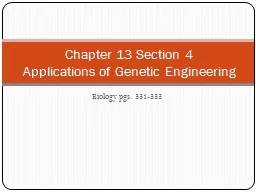

Applications of Genetic Engineering Objectives the usefulness of some transgenic organisms to humans Describe Transgenic Organisms An organism described as ID: 780131
Download The PPT/PDF document "Biology pgs. 331-333 Chapter 13 Section ..." is the property of its rightful owner. Permission is granted to download and print the materials on this web site for personal, non-commercial use only, and to display it on your personal computer provided you do not modify the materials and that you retain all copyright notices contained in the materials. By downloading content from our website, you accept the terms of this agreement.
Slide1
Biology pgs. 331-333
Chapter 13 Section 4
Applications of Genetic Engineering
Slide2Objectives
____________________the usefulness of some transgenic organisms to humans.
Describe
Slide3Transgenic Organisms
An organism described
as_______________,
contains genes from other species.
Genetic engineering has spurred the growth of biotechnology.
transgenic
Slide4Transgenic Microorganisms
Transgenic bacteria produce important substances
_______________for
health and industry. Transgenic bacteria have been used to produce:
insulin
growth hormone
clotting factor
useful
Slide5Transgenic Animals
Transgenic animals have been used to study genes and to
__________________the
food supply.
Mice have been produced with human genes that make their immune systems act similarly to those of humans. This allows scientists to
______________the
effects of diseases on the human immune system.
improve
study
Slide6Cloning
A
_______________is
a member of a population of genetically identical cells produced from a single cell.
In 1997, Ian
Wilmut
cloned a sheep called Dolly.
clone
Slide7Researchers hope cloning will enable them to make copies of transgenic animals and help save endangered species.
Studies suggest that cloned animals may suffer from a number of
_____________________and
health problems.
genetic defects